Sample Undergraduate 2:1 Marketing Dissertation | UKEssays.com
See for yourself why we're a leading academic writing company. One of our expert writers has created this bespoke sample Marketing dissertation that shows the quality of writing that's guaranteed with every piece of work ordered. Secure your academic success and place an order today or view our Dissertation Writing Service.
The Evolution of Marketing Strategies used by Fashion Retailer Primark
Abstract
Fast fashion has grown in popularity tremendously, impacting multiple stakeholders. With the development of supply chain, operational, logistical and strategic principles, competition becomes ever fiercer. This study is aimed at illustrating what marketing strategies were adopted by one of the most progressively growing retailers in the fast fashion industry – Primark, throughout its historical development. The undertaken Netnography analysis set out to answer the question: What are the critical components of Primark’s marketing strategy, that motivate their online supporters to continue purchasing from the brand? Overall, findings illustrate a steady transition from traditional to contemporary marketing tools and techniques, guided by the core principles of operation, allowing brand equity to be built throughout time with minimal investment and utilisation of user-generated media, content and advocacy, used by the brand for promotion.
Contents
Click to expand Contents
Chapter I. Introduction
Graph 1. Clothing Market Share Growth of Primark (2007 – 2018) (Statista, 2018a).
1.2.Identification of research gap.
1.3.Overall Research Aim and Objectives.
Chapter II. Literature Review.
2.1. Introduction and Method of Review
2.2. Fast Fashion’s Defining Theory
2.3. Primark’s Founding Strategy and Motivations
2.4. Transition Period: Growth and International Market Penetration
Image 1. Primark’s sub-brands.
2.5. Criticism of Primark’s approach.
2.5.1. In terms of CSR and working conditions.
2.5.2. In terms of Originality.
2.6. Primark Today: Contemporary Marketing Strategy.
2.7. Summary and Direction for Further Research.
Chapter III. Methodology
3.1. Introduction, Overview and Sample.
3.4. Data collection and Ethics of Netnography.
3.5. Data Interpretation and Analysis.
Table 1. Summary of Applied Methodology.
Chapter IV. Analysis and Discussion
4.2. Primark: The Experience and its Shopper Community
Image 3. Vlogger’s response to questions regarding sponsorship.
4.3. Effect on Colour on Volume of Purchase.
4.5. Disturbance amongst the Community.
Image 4. Consumer feedback on store re-modelling.
4.6. Summary: Addressing the Research Question.
Chapter V. Conclusion
5.3. Recommended marketing direction.
5.4. Future research directions.
Appendix 3. Influencer Zoella (Source: Youtube, n.d.)
Appendix 4. Facebook Search for Fan-Based communities and Lack of Data validity (Source: Facebook)
Chapter I. Introduction
1.1. Background.
The clothing industry has changed tremendously over the past decade, driven by the growing interest of consumers in their appearance, rapid swift in current trends and social pressure to remain relevant in terms of fashion. According to Research and Markets (2017), the UK clothing market is expected to grow by a further 16.6% between 2017 and 2022, making it third in terms of growth speed, after the health & beauty and food & grocery industries.
Industry growth arises following a combination of factors. Some authors argue that fast fashion is a result of the widescale globalisation, which enabled a distribution network with remote production facilities (Jones, 2006; Bruce et al., 2004). Others consider the global recession as an economic factor, which has influenced consumers to be warier of their spending, making cheaper apparel more appealing than higher-quality or more luxuriously branded clothing (McColl and Moore, 2011; McCormick et al., 2014). Behaviour towards fashion has also changed, with self-expressive consumption on the rise (Sudbury and Böltner, 2011), but not in the traditional sense of exclusivity or originality, but through what is referred to as ‘massclusivity’ – a widely available offer that is affordable for the average-earning buyer, but also tasteful, experiential and compellingly branded (Tokatli, 2008). Digitalisation also influenced buyers’ awareness of pricing and purchasing options, acting as a catalyst for increased impulsivity, easily triggered by sales promotion and low-price tags (Christopher et al., 2004; Runfola and Guercini, 2013). The result of all the above is the emergence of ‘throwaway’ fashion, responding to the needs of recovering (Western) economies and the emerging (Eastern) consumer and production markets (McCormick et al., 2014; Filieri, 2015).
According to McKinsey’s (2017) report, the consumer of 2018 is connected, tech-savvy and seeks information from online communities, with which to exchange product reviews, suggestions and advice. Most importantly, it is commonly expected from a company to provide quality, sustainability, convenience, good price and relevant trends (McKinsey, 2017). Looking at the UK market specifically, digitalisation is a growing trend with consumers seeking online and mobile accessibility of purchasing (Mintel, 2017). Although most companies adhere to these requirements, there are exceptions in terms of the adoption of new technology, such as the low-cost retailer Primark, who is growing exponentially in the UK market, as can be seen in Graph 1 (below).
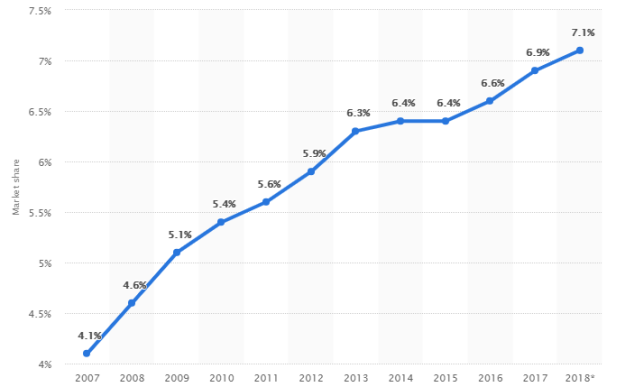
Graph 1. Clothing Market Share Growth of Primark (2007 – 2018) (Statista, 2018a).
1.2 Identification of research gap.
Although fashion and fast fashion are fields of considerable interest for researchers, it is useful to understand not only what the common practices are across the industry, but also the methods of getting ahead of the competition as a new entrant. As Primark is an organisation, which in many ways summarises the life cycle of fast fashion companies, such as in terms of supply chain network design, retail environment management or corporate social responsibility, it can be argued that it also offers researchers a unique perspective of the market due to its marketing strategy, generating a wider brand appeal and imminent international growth at a rate, faster than its competitors (Butler, 2018).
The relationship between the actions of the organisation during its stages of national and international growth and movement from traditional to neo-traditional marketing approaches has not yet been thoroughly synthesised. Another key aspect of the brand popularity – its online community, is also yet to be researched. A reason for the relative lack of studies of Primark’s corporate social media (see Jones et al., 2009; Arriaga et al., 2017) and digital official (see Dach and Alimendinger, 2014) or fan-created spaces is the comparatively recent entry of the organisation to social and digital media. Contrastingly, another longer-standing competitor of the organisation – ZARA, has been extensively researched in contemporary literature (see Ghamawat et al., 2003; Lopez and Fan, 2009; Cuc and Tripa, 2007; Hansen, 2012; Ferdows et al., 2005; Wilems et al., 2012; Lloyd and Luk, 2010). Conclusively, a preliminary rationale for the current project can be justified.
1.3 Overall Research Aim and Objectives.
The aim of this project is to critically analyse the historical progression of retailer Primark’s marketing strategy with the goal of providing informed (by literature and primary research) managerial suggestions for the progression of the organisation and others in the fast fashion industry, as well as informing other researchers of possible directions, using the company as a case study organisation.
The research objectives are designed, using Doran’s (1981; Meyer, 2003) framework of SMART (specific, measurable, assignable, realistic and time-related) objectives. Thus, this project can be considered successful, if it can adhere to the following objectives:
- To provide a synthesis of collected literature, summarised and critically assessed in line with the evolutionary development of the case study organisation – Primark;
- To indicate a clear methodological structure of conducting a netnographic exploratory observation of online communities and execute it in a timely manner, with the goal of assessing the effectiveness of the organisation’s marketing strategy and identify possible future strategic directions;
- To relate findings to wider pool of available literature and produce key recommendations for the organisation for increasing its brand appeal.
The following dissertation contains of four further chapters, structured as follows: Literature Review (II.), Methodology (III.), Analysis of Results and Discussion (IV.) and Conclusion (V.). In the next chapter the evolutionary stages of Primark’s progression will be defined, alongside the relevant marketing strategies executed for each of them.
If you need assistance with writing your dissertation, our professional Dissertation Writing Service is here to help!
Find out moreChapter II. Literature Review
2.1. Introduction and Method of Review
Studying Primark as an organisation allows a wider scope of literature to be examined, which falls in the category of low-cost and fast fashion, as the organisation can be identified with common characteristics of other companies, operating in these industries. The following literature review consists of several sections, the design of which allows a tracing of the historical development of the marketing strategies, adopted by the organisation. The structural approach and writing style are therefore narrative (Hart, 2018), however a critical outlook has been adopted in terms of synthesising commonalities and contrasts, which will assist the goal of evaluating of the company’s unique proposition, which will later be used as a ground for summarising the research question for the netnographic observation (Baumeister and Leary, 1997). Studies from journals and media articles have been purposefully selected to fit the narrative of the review, causing it to suffer from researcher bias. The effect of this has been mitigated by maintaining a neutral tone throughout, as well as through a critical approach in evaluating the validity of the chosen studies, their findings and their implications on the case study organisation.
2.2. Fast Fashion’s Defining Theory
Lopez and Fan’s (2009) and Runfola and Guercini’s (2013) studies coin the term ‘Fast Fashion Formula’ (FFF) through researching the progression of low-cost fashion retailers, placing a considerable focus on supply chain network characteristics, rapid manufacturing and means of entry to new international markets. The structural approach of these studies was influential in illustrating and differentiating the three stages of development of an international retailer: (1) launch and definition of market focus, (2) expansion and shift in collection delivery strategy and (3) model adjustments in line with further expansion initiatives, which was utilised as a guide in terms of the assessment of Primark’s evolutionary steps.
Retailers, operating in the fast fashion industry are guided by four principles, which will be detailed below (Tokatli, 2008; Ferdows et al., 2004; Dunford, 2006; Christopher et al., 2004). Initially, it is aimed for the organisations to reach a high number of owned stores to maximise profit. However, franchise opportunities are provided, if a market is considered a high-risk investment (Christopher et al., 2004). Secondly, a disruption of the traditional collection planning model is achieved through deploying a responsive to fashion trends information system and a process that excludes the need for consumer and market research prior to design. This leads to a faster development stage and prototype production. As a consequence of the shorter time-frame, the number of collections released can be and is increased, leading to a falsely induced perception of exclusivity, which urges consumers to purchase apparel at a full price, instead of waiting for seasonal sales promotion and discounts (Ko and Megehee, 2012; Joy et al., 2012; Tokatli, 2008). The final characteristic, allowing the illustrated model is the supply chain, which is defined by its flexibility, adaptiveness and quick response to requirements or changes.
This model is thought to have been pioneered by Zara and H&M, the former placing style as a selling proposition, whereas the latter emphasises affordability (Arriaga et al., 2017). Primark, however took this model a step further with a rock-bottom pricing, placing emphasis on low prices and continuously frequent renewal of styles in-store. The sections to follow will analyse the strategic models, used throughout the organisation’s history.
2.3. Primark’s Founding Strategy and Motivations
Primark is a subsidiary of ABF (Associate British Foods) PLC, which own businesses in other industries as well, namely sugar, agriculture, groceries and ingredients (ABF, 2012). It was launched originally in Ireland as Penneys in 1969 and in the UK as Primark in 1973. Its international expansion began in 2006 with Spain being the first market to penetrate, followed by an aggressive penetration of other European countries and in 2015 a penetration of the American market as well (Primark, 2018), resulting in a total of 182 stores in the UK, 155 in other European Countries and 8 in the USA as of 2017 (Statista, 2018b).
The experienced success in terms of internationalisation and rapid expansion of number of stores was due to the strategic fit between the company’s proposition of “Amazing Fashion at Amazing Prices” and the economic times, following the global recession. Primark’s brand quickly became known as a destination for extremely cheap, low-quality apparel, stacked in a chaotic and warehouse-like retail environment. At the start, the organisation cared to attract value-conscious consumers (Mellahi et al., 2002) and did not apply any further segmentation techniques, resulting in their customers varying significantly in terms of demographic or psychographic characteristics (Easey, 2009).
In terms of supply, during these initial stages Primark invested in developing a Quick Response (QR) supply chain strategy (Lin and Parlaktürk, 2012), allowing the organisation to benefit from the outsourcing of labour to emerging, developing economies with a lower rate of pay, such as China, India, Bangladesh or Turkey (Grant, 2018; Arriaga et al., 2017) and globalisation of trade, later becoming the pre-requisite to its expansion.
Aaker (1992) identifies five components of the total equity of the brand, namely (1) brand loyalty, (2) perceived brand quality, (3) brand associations, (4) consumer brand awareness and (5) other proprietary brand assets. No new market entrant can tackle the achievement of all those at once, hence why Primark in its early days focused on utilising the support of its parent organisation in terms of asset structure, allowing a steady growth in domestic markets (Ireland and UK), raising awareness for the brand and generating loyalty amongst budget fashion shoppers. The latter two were achieved through traditional marketing techniques and a clear proposition.
Primark’s approach to marketing was through offline printed mass media, such as billboard or bus ads (see Appendix 1). The offline approach has been historically associated with a high potential reach (Kolo and Vogt, 2004), which was beneficial for the organisation at the time, as it offered an irresistible market proposition of low-cost fashion, which aligned to the financial state of most people, who lacked high amounts of disposable income to spend on fashion. Thus, during the boom of e-commerce and online corporate webpage development, Primark remained true to an entirely offline model.
The initial formula can then be summarised through a clear-cut value proposition, low property rental costs (Ziskind et al., 2011), low investment in management of the retail environment or customer service (Arriaga et al., 2017) and a responsive supply chain, producing fashion in a quick manner in small batches, allowing new products in-store each week (Runfola and Guercini, 2013). Primark’s marketing strategy was highly traditional and modest at start. Combined with the awareness, built through offline stimuli and word-of-mouth (WOM) (Jones et al, 2009; Arriaga et al, 2017), consumers responded with repeated visits to the store and frequent purchases (Ziskind et al., 2011), in turn generating a subconscious loyalty to the brand. It can be argued that Primark captured audiences through staying true to their unique proposition of being the cheapest and trendiest fast fashion retailer (Zhou et al, 2015) and turned it into a competitive advantage.
2.4. Transition Period: Growth and International Market Penetration
The second stage is growth through international expansion and new market penetration. In terms of supply chain QR became GQR (Global Quick Response), characterised by an effective management of four elements – operation, supply, production, inventory and logistics (MacCarthy, and Jayarathne, 2010). Driven by the need to quickly replenish styles, which are in demand and ‘dispose’ or relocate others, which are no longer trending, the requirements for better partnerships with suppliers and a robust information system is continuously raising the bars across the industry (Tokatli, 2008). Operational effectiveness is measured by time-to-market. Collection planning follows the traditional steps, however the process is sped up with the goal of fast planning and delivery of up to 60 days across the industry, as per the studies of Cietta (2008), naming H&M and Zara and Runfola and Guercini (2013), whose study focus was Tessilform.
With the growth of the industry, consumer have become more demanding in terms of product quality, with this influencing the supply chain as well (Tokatli, 2008). Fast fashion retailers, seeking success responded to improving their partnerships with production facilities, urging them to be adaptable and quicker in terms of response and production (Bhardwaj and Fairhurst, 2010). This has, however, backfired as human rights activists stepped in with requirements for ethical treatment of workers in production facilities, with many organisations being exposed at lacking the deployment of sustainable practices. Such allegations against Primark will be discussed in section 2.5 below.
With the changes in the supply chain taking place, Primark had to ensure that consumers align their perception of style obsolescence with the rate of production and store replenishment. This meant promoting newer styles more often (Ko and Megehee, 2012) and creating an image of a one-stop-shop, in order to encourage the volume of sales on a single visit (Doherty and Ellis-Chadwick, 2010). According to Ziskind et al. (2011) the stock in Primark’s shops is entirely replenished every 6 weeks. This store strategy was beneficial not only in terms of psychological conditioning of the consumers of the brand, but in terms of new market entry, as the company began penetrating new markets through a single flagship store at a key location (Primark, 2018).
Flagship stores are generally the biggest in terms of variety of merchandise offered and are owned by the company (Frings, 2009). They allow consumers not only to shop, but to immerse themselves in the environment of the brand, getting a sense of the brand personality (Kozinets et al., 2002). This is generally good for the retailer due to the control they have over this environment. Traditionally, this form of market entry was used by luxury fashion brands as a means of captivating a new geographical market and establishing a presence (Moore and Doherty, 2007). However, due to the growing popularity of fast fashion brands, it is now a common practice for retailers such as H&M (Arrigo, 2018) or Primark (2018) to launch through such a store layout. Establishing a presence increases the consumer awareness for the brand and maintaining a pleasurable experience through a controlled environment can ensure positive brand associations – both of which result in a higher brand equity (Aaker, 1992).
In order to remain relevant and appealing to the fashion preferences of consumers from different geographic territories, Primark avoids homogenising and engages in what is referred to as ‘glocalisation’ – the adaption of global operational practices to local customer attitudes, traditions and preferences (Robertson, 1994). By doing so, it is argued that Primark not only ensures an appeal for its apparel, but also encourages style collaboration and research of the local culture, which can be later utilised in terms of understanding the vulnerabilities of the consumer market and producing apparel this will fly off the shelves at the fastest rate (Sharma, 2016).
Finally, during this transition a cultural shift also took place, transforming clothing’s purpose from purely functional into complex, carrying many socio-cultural consequences for the consumer (Davis, 1994). Primark’s response to the experienced pressure in terms of consumers’ associations with the brand being ‘trashy’ related to its early days, when it was lower in quality and durability, was a re-design of packaging and introduction of 12 new brand identities, as can be seen in Image 1, below. The justification, according to the creative agency, who worked on the project was to illustrate the ‘democratisation of the catwalk’ looks (The One Off, 2018). Following this, on the media website, Primark’s sales are reported to increase by 16% (The One Off, 2018). Examples of the new packaging and new retail environment outlook are further illustrated as Appendix 2.

Image 1. Primark’s sub-brands.
2.5. Criticism of Primark’s approach.
Although the brand evolution is evident, what the brand did not anticipate and prepare for appropriately is the growth of consumers’ involvement in corporate operations, specifically in terms of ethical treatment of workers, sustainability and Corporate Social Responsibility (CSR), which impacted and continues to impact the public image of the organisation very negatively.
2.5.1. In terms of CSR and working conditions.
For example, in 2014 a media scandal broke out through an allegation of poor working conditions and unethical treatment of workers in Primark’s factories in China, following the discovery of a note, which was structured as a cry for help from one of the workers there (Image 2) (McAteer, 2014).

Image 2. Note and ID card of an alleged ‘prisoner’ from one of Primark’s production facilities in China (McAteer, 2014).
Contrastingly to the media coverage and negative press, the sales of Primark continued to grow. This is relative to research findings of Yu, Cao and Tan’s (2018) studiy, whose focus is the relationship between pro-social consumption and actual purchase behaviour, the conclusion of which being that although consumers have intentions towards better working conditions, ethical treatment or sustainable consumption, they often fail to reflect it with their purchases, placing responsibility at the organisation not to engage in unethical practices.
Dach and Allmendinger’s (2014) study on the other hand illustrates that contrastingly to actual unethical practices (or allegations of such) and negative media coverage, Primark’s ‘sustainability and CSR’ website section is considered honest, credible trustworthy and easy to access. Comparatively, the authors conclude Primark’s website is an advantage and H&M’s website is a hindering of their actual efforts. Nonetheless, it is shown to add little value to the purchasing decision of their consumers. Jones et al. (2009) further add to the discussion by illustrating that the company itself has in the past withheld from comments on unethical treatment of workers, allowing its brand advocates to clear the public outrage on social media. Their discussion sheds light on the strong brand appeal during a time when the company had yet to take on social media officially, but their followers had started a society with hundreds of thousands of followers, used for exchanging opinions, product reviews, fashion tips and (as illustrated by Jones et al. (2009) clearing up a PR mess. Although not a result from a direct investment, perhaps not even an anticipation on behalf of Primark, their success in social media and electronic WOM has been recognised by social media professionals and academics (Richardson and Gosnay, 2010; Harries and Rae, 2009).
2.5.2. In terms of Originality.
The brand has also been widely criticised for ‘stealing’ design concepts and copyright infringement, however skilfully dodging responsibility through the policy of quick style obsolescence (Sharma, 2016). Over the years, the company has been continuously attacked both by its followers, private labels (Rear, 2017) and even competitors H&M (Armitage, 2005) or Monsoon (Frith, 2005) in stealing designs. In all cases, Primark is rarely taken to court as settlements are often negotiated following a confirmation of the validity of allegations (Armitage, 2005).
2.6. Primark Today: Contemporary Marketing Strategy.
Arguably the biggest transition experienced in recent years is the launch of corporate social media. As previously discussed, Primark already had accumulated a large following, which as authors argue is due to the high public profile that the organisation maintained throughout its development, keeping it always in the public eye, generating conversations naturally, as opposed to through direct investment in advertising (Jones et al., 2009). Fashion items are found to be a common conversation topic, as consumers often seek advice (Wolny and Mueller, 2013) and self-expression through apparel (Gu, Park and Konana, 2012).
The organisation’s social media has been criticised for lacking engagement with the audience (Arriaga et al., 2017). However, it can be argued that this might be due to the initial skyrocket of number of followers, attracted by their social media page of Facebook, attracting 1.7M fans in six months between 2013 and 2014 (Ratcliff, 2014), currently standing at 5.6M as of Autumn of 2018. Primark also captivated YouTube through contracting influencer Zoella in 2017, to act as an ambassador for the brand, who further increased Primark’s appeal amongst Millennials (Appendix 3). The shift in strategy experienced is that instead of relying on naturally generated WOM, as previously illustrated, the company is actively reaching to its target market. Influencers have been researched as a preferred method for contemporary organisations of using people, who have accumulated a following in social media with a fan-base, similar to the target market of the organisation to charm their own followers to become purchasing customers of the supported brand (Smith et al., 2018). As researched by Leary (1995), the effectiveness of such indirect selling is higher when the public persona integrates a high level of personability through revealing exclusive information about their personal life and actively engages in impression management, which is exactly what has given Zoella her rise to fame.
Finally, many fashion companies were early adopters of e-commerce, as it provided another point of sale, which out-performed traditional brick-and-mortar retail environment selling in terms of geographic, lifestyle and demographic appeal. Although authors recommend an omni-channel retailing strategy (McCormick et al., 2014), the effective management of the digital presence of fast-fashion retailers has been criticised due to lack of brand consistency, engagement or after-sale care (Rowley, 2009). Widely, connectivity and internet mobility resulted in a societal push for organisations to become digital and social (Mohr, 2013). It can be argued that although there is a push for digitalisation of sale access points, Primark uses the lack of an online store as a unique competitive advantage – not in terms of consumers, but in terms of their competitors, as this strategy further encourages the repeated visits to their physical outlets.
2.7. Summary and Direction for Further Research.
As illustrated throughout, there are various sources, who in full or partially have discussed the operations and significance of Primark to the fast fashion industry (namely Arriaga et al. (2017), MacCarthy, and Jayarathne (2010), Jones et al. (2009), Dach and Allmendinger (2014), amongst others). Throughout the literature review, however, a significant lack of studies, focusing on consumer behaviour has been identified. This has lead authors, such as Bhardwaj and Fairhurst (2010) to advocate for analysis of motivations, desires and preferences of consumers. Thus, this project sets to inquire why consumers continue to choose Primark amongst other retailers, enabling its continuous growth. Such an investigation can be useful in terms of understanding the motivations and attitudes behind the consumption of low-cost fashion, as well as for managers in the industry. Most importantly, the analysis can enable a synthesis of the important factors (from the perspective of the consumer), which make a brand stand out and will enable a discussion for future strategic directions in terms of marketing for Primark.
In order to achieve transparency of results relative to them not being bound to a specific geographic location, an explorative netnographic approach is adopted for the analysis section, the methodology of which will be discussed in detail in the next chapter.
If you need assistance with writing your dissertation, our professional Dissertation Writing Service is here to help!
Find out moreChapter III. Methodology
3.1. Introduction, Overview and Sample.
This chapter of the dissertation will concern itself with providing the structure and the justification of the methodological approach, used to answer the question:
What are the critical componentsof Primark’s marketing strategy, that motivate their >online supporters to continue purchasing< from the brand?
The research question is exploratory in nature and conveys the immersive nature of the proposed study, as well as illustrates a clear focus for the research direction, yet further research directions are required, in order to ensure a unique and holistic perspective to the complex world of Primark’s digital consumer (Kozinets, 2010). Thus, the sub-categories of the proposed research are in need of online shopping options, effect of branding on perception of apparel quality, value and volume of purchase, sustainability and methods of promotion.
As this study traces the marketing strategy of a specific organisation, the research sample is site-specific, intimately linking the findings with the organisation itself (Bloomberg and Volpe, 2012). This does not, however, hinder the researcher in terms of generalising and theorising, based on the insight (Kozinets, 2010; Denzin and Lincoln, 1994). The sites used for this study are social media networking platforms – Twitter, YouTube and Facebook, as they have been identified as the most thriving online communities of both supporters and proponents of the brand, allowing a non-biased sample and data for analysis.
3.2. Background to Method.
The amount of data, which is shared online each day had dramatically increased in recent years. Mobile technology and emerging markets just getting connected to the Internet on a wide scale enable a future, where countries and people are going to be as accurately re-presented online, as they are in reality. This line of thinking and the evidence found in the digital traces, left from naturally-occurring conversations, has enabled researchers to believe that online communities offer honest, credible and data-intense insight to culture and emotions of consumers (Kozinets, Dolbec and Earley, 2014).
Researchers have sought to utilise these benefits of online data and communities, deploying an approach, which allows the observation of naturally occurring behaviours, as it immerses the researcher in the contextual environment of the online community. It offers an opportunity for observing and describing behaviours, as well as critically analysing them though experiencing them as part of the community (Guba and Lincoln, 1981). Philosophically, the epistemological and ontological assumption of Netnography is that it is interpretative and exploratory, classified as a qualitative primary investigation, which can be participatory and non-participatory (passive). The latter, however, is argued to be classified as a simple observation as opposed to netnographic research and is argued to have multiple limitations (see Costello et al., 2017). When compared to traditional ethnography, it is thought that this method is more advantageous as it overcomes the limitations of geographical belonging and research population demographics, as well as saves time for both the participant and the researcher, enabling what is often a more insightful inquiry (Kozinets, Dolbec and Earley, 2014).
3.3. Role of Researcher.
Researcher’s role is of a conversationalist and an active member of the community, manifesting a behaviour, which is common to the group, creating a perception of shared motivations and beliefs and contributing equally in a creative and interesting way (Kozinets, 2010). Acting as an instrument, urging and facilitating discussion, as opposed to hindering it by being obtrusive, for which an immersion in the research context is mandatory to ensure validity of results (Guba and Lincoln, 1981).
3.4. Data collection and Ethics of Netnography.
There are two types of data, collected during a netnographic inquiry – obtained directly from the system and obtained through interactions with online users, part of the communities that are being researched (Kozinets, 2010; Beaulieu, 2004). Combined with the role of the researcher in terms of being able to assess when to use direct data without interpretation and when to interact and observe reaction, the type of data used considered what makes this method stand out in comparison to traditional ethnography (Bowler Jr, 2010), where mostly passive observations are utilised as data (Willis and Trondman, 2000).
Specific to the current research, data has been collected from the following sources as follows:
- Twitter: Twitter is one of the largest social medias, with around 6,000 tweets per second (as per Internet Live Stats, 2018), making it a curious field for researchers, seeking for instant and short-winded reply to stimuli. This platform has been searched for the keyword ‘primark’.
- Facebook: With over 5.6M followers on the official Primark page, Facebook brings unique insight due to the space it provides for self-expression on the platform; through reactions, comments, reactions on comments, etc. Contrasting to assumptions, an official ‘community’ has not been established by the organisation, and fan-based communities such as examples from Appendix 4 fail to produce relevant data for the study. Thus, the collection of data has been done primarily through utilisation of the comment section of corporate posts on the official page.
- YouTube: As discussed in Chapter II., Primark has engaged in promoting its brand through influencers, which has resulted in a wide range of YouTube videos of the so called ‘Primark Try-On Haul’. The comments section of those provides intriguing insight to the culture of consumers at various stages of their interaction with the brand, some new, others previously unaware of its existence, or those, who have been regulars for years.
Following the guidance of the researcher’s etiquette, the several steps have been taken to ensure ethical conduct during the data collection, namely:
- Announcing presence in the community and nature of research.
- Ensuring confidentiality and anonymity of participants, in line with GDPR and DPA acts of 2018 and 1995, respectively.
- After the inquiry ended, feedback from the community has been sought.
- When using direct quotes, the identity of originators has been covered.
- All data presented has been obtained through the public domain.
(Kozinets, 2002; Kozinets, 2010)
3.5. Data Interpretation and Analysis.
Data is generally considered a trustworthy source of information, as online behaviour is part of the digital self, which is thought to be an extension of the actual self (Belk, 2013), much as our possessions or social behaviours in various situations, regarded as standing on varying degrees of synergy to the actual self (Belk, 1988).
The coding of data is done in an analytical way, going through the stages of coding, noting, abstracting, checking and refining, generalising and theorising (Kozinets, 2010). The analytical approach is hermeneutic, using global meaning to understand individual elements, which are then used to form a revised global meaning, which incorporates the data (Kozinets, 2010). Thus, continuous refinement is achieved in line with the changing nature of consumer behaviour. The analysis is kept in line with the overall research direction, question and sub-questions, posed above in section 3.1.
3.6. Limitations.
This research has several limitations. Due to exploratory nature and the structural narrative, it is understood that the interpretation of literature findings, analysis and theorising is subjective to the researcher’s bias (Silverman, 2013; Denzin and Lincoln, 1994). Furthermore, although use of various sources has been utilised throughout this research project, the transparency of findings is limited due to the case study focus on Primark and their consumers. Considering Belk’s (1988; 2013) work with regards to the extended self and digital identities, a critical approach is to be adopted in terms of data validity as a reflection of true intentions and accurate representation of actual consumer behaviour. This can potentially hinder the validity and credibility of the findings, if further research is not undertaken to test the developed hypothesis in a real setting, such the actual retail environment.
3.7. Chapter Summary.
In this chapter the philosophical, theoretical and practical characteristics of Netnography were presented and critically analysed to assess the suitability of this research design in terms of addressing the questions of inquiry. Following this the methodology of the present study was defined, specifically illustrating the challenges and unique aspects of this approach. A summary is presented as Table 1, below.
Level of Decision | Choice |
Epistemological and ontological assumption | Qualitative, Exploratory, Interpretative |
Strategy of Investigation | Netnography |
Techniques |
|
Organisation | Primark |
Field of Analysis |
|
Broad Subject | Consumer perception of critical components of marketing strategy |
Type of Data Used | Text |
Coding Strategy | Analytical |
Analysis Approach | Hermeneutic |
Table 1. Summary of Applied Methodology.
If you need assistance with writing your dissertation, our professional Dissertation Writing Service is here to help!
Find out moreChapter IV. Analysis of Results and Discussion
4.1. Introduction
The following chapter will analyse the findings of the research and present them from a holistic perspective whilst addressing the research question, posed in chapter III. The narrative has been guided by the evidence from the community as per the research agenda, specifically the sub-questions. To ensure a smooth flow throughout, findings are approached from a critical stance and discussed in the context of other literature throughout the chapter.
4.2. Primark: The Experience and its Shopper Community
In Chapter II, Primark’s approach to selling was critically explored, where from the company’s perspective the policy of in-store shopping is aimed at encouraging volume of sales – something crucial for the longevity of the organisation, due to its production, operation, logistics and supply chain costs in light of low prices (Lopez and Fan, 2009; Runfola and Guercini, 2013; Tokatli, 2008; Ko and Megehee, 2012; Joy et al., 2012). Consequently, this has influenced people’s perception of Primark as a whole. To elaborate, people often refer to their shopping experience as ‘taking a trip’, ‘getting a Primark fix’, ‘a treat’ or ‘a Primark therapy’, which implies the hedonic (fun, enjoyable) value that the store provides to its consumers (Babin et al., 1994). Therefore, it can be argued that consumers shop not only to obtain goods, but to create an experience and trigger a certain emotion (Hirschman and Holbrook, 1982; Diep and Sweeney, 2008).
The discovered community across the researched online media consisted primarily of females, representing women of all ages, body image and experience level in terms of their interaction with the brand. This is in line with the earlier assumptions with regards to shopping value, as Diep and Sweeney (2008) study shows that females place a greater importance on hedonic experiences and have a higher tendency in making choices, based on symbolic reasons. A commentator on YouTube shared:
“I went to Primark for the first time this year when I went to London!! I went to the one on Oxford street, I was so overwhelmed, but it was amazing.”
Although it seems that at first many newcomers find stores too big, unorganised and apparel, advertised online, hard to find in-store, as time progresses it becomes evident that the ‘hunt’ is part of the brand personality and the overall experience. Primark is messy, but cheerful and positive. Customers often reported going to multiple locations, prior to finding an item, but feeling fantastic once they have. It can be argued that the subsequent feelings appear stronger, informing an assumption that the overall experience was worth it. YouTube Vlogger Amelia Rose Park openly admits:
“Okay guys - I have an addiction to Primark and I'm not even joking”
Relative to Christopher et al.’s (2004) and Runfola and Guercini’s (2013) findings, it can be argued that Primark’s community of shoppers can be identified as being impulsive, as many shoppers have shared going to the shop straight after watching a ‘haul’ on YouTube or seeing a corporate media, sharing newly released products.
Shoppers on the social media exchange opinions on everything Primark-related from their shopping experience to stock levels, recommendations, job opportunities, general information, hints and tips and so on. There is a natural feeling of belonging, once initiated in the community, where everyone shares the love of ‘cheap and cheerful’ prices and bright colours. However, it is argued within the community that ‘cheap’ is not the best word to describe Primark. Some commenters on YouTube have argued such a definition deprives from the product quality:
“…“cheap” definitely has a more negative connotation”
or
“I'm American and I personally associate the word cheap with clothes that aren't a great quality. I think affordable is a good word for something that is of good quality and a good price.”
The popularity of the brand spans across the globe, with people from Australia, India, Canada, different countries in Europe or South Africa, writing directly to the company via Twitter or Facebook, asking for a shop to be opened where they are, to which Primark responds with polite gratitude, with what often appear generic statements, used by their customer representative team. It goes on to show, however, that eWOM has persuaded shoppers worldwide to become obsessed with the brand, even prior to its launch in some foreign markets.
The findings presented in this section regarding gender belonging of consumers, effect of eWOM on purchase intention and hedonic value in the experience confirm the findings of Fan and Miao (2012). Their study concluded that amongst female online communities, eWOM generates credibility as their interpretation of products often combine practical and experiential characteristics, resulting in the generation of a stronger purchase intent in observers through a showcase of expertise and brand involvement. What this results in is a community, with clearly defined roles, which are dependent on experience. The more experienced guide the newcomers and can potentially clarify organisational positioning, mission or act as an ambassador, an extension of the brand, generating a bond amongst community members, associated with the brand (Hung and Li, 2007).
In Primark’s consumer society the primary form of ‘teaching’ is done through YouTube. Previously it was discussed that part of the contemporary marketing was the use of Zoela, acting as an influencer on behalf of the brand. Zoella’s average reach on a Primark-related video is around 4M. However, ‘PRIMARK HAUL’- titled videos have become a trend amongst members of the YouTube community and hundreds of videos surface each week with the words in the title. Such videos attract a lot of attention and can serve as an advertisement of a contemporary nature, reaching a wide demographic of potential purchasing customers from various demographic locations (Keats, 2012). This form of user-generated media encourages excessive consumption, which is beneficial for Primark’s business model and it can also act as an extended fashion catalogue for the organisation (Keats, 2012), for which they do not have to invest in, as the ‘models’ often generate the clips without being sponsored by the organisation, as one vlogger shares:

Image 3. Vlogger’s response to questions regarding sponsorship.
4.3. Effect on Colour on Volume of Purchase.
Throughout the analysis it became evident that Primark is often complimented on using bright colours and cheerful designs, utilising sentiment towards other brands such as Harry Potter, Pringles, Disney and others, by launching apparel with another brand’s imagery. The bright colours on the other hand appear to stand from the competition, with many users, sharing the opinion that Primark is the only high-street brand that ‘doesn’t look dull or depressing’.
Colour can and is used by organisations as a method of stimulating the consumer and attracting their attention to guide them through their shopping experience to a desired outcome (O'Connor, 2015). In Primark’s case this outcome is a large volume of purchases. It is recommended that retail managers of fashion brands manage the atmospheric cues, such as lighting or colour in line with their consumers’ self-image (Ballantine et al., 2015). With younger generations being the primary target market of the company, colour-intense products on display act as a trigger for purchasing even higher volumes due to the continuous stimulus, whilst in-store.
4.4. On Sustainability.
Although most consumers ‘need’ their ‘Primark fix’, there are those, who express concern with the overall apparel consumption level of society and its effect on sustainability. As a consumer, wary of the consequences of fast fashion comments in reference to a ‘haul’ video on YouTube:
“I think as a society we need to recognise some of the problems the current fashion industry has and how videos like this contribute to this model…this isn't hate, just want to spread some awareness”
There are many scholars, which have addressed the issues of fashion obsolescence, volume consumption and their effect on sustainability. McAfee et al.’s (2004) research shows fast fashion brands produce garments that are only meant to be used less than 10 times, prior to disposal, which creates numerous problems in terms of waste management or sustainable sourcing for production (Birtwistle and Moore, 2007). Binotto and Payne (2017) provide another perspective on the matter, illustrating the need of fashion companies to assist the growth of re-purposed clothing as fashionable and trendy.
Although consumers are becoming aware of the effect of ‘throwaway culture’, they fail to address them through their actual purchase behaviour, mainly guided by concerns of price and affordability (Ritch and Schröder, 2012). Thus, an attitude-behaviour gap is defined when it comes to ethical purchasing, fashion consumption or disposal of apparel (Sudbury and Böltner, 2011). In YouTube’s comments section, consumers also share:
“It’s like… I’ve been to ten stores and skinny jeans are always 40 pounds, I go to Primark and BAM – a fiver! It’s insane.”
Regardless of the effect, it can be argued that a business will always step in to fill a gap in the market, whether it is Primark or another organisation, it is the consumers of this model that progress it. As a Twitter user sums up a discussion on the matter:
“Primark lives in a society.”
4.5. Disturbance amongst the Community.
4.4.1. Online Store Appeal
Throughout the analysis there were multiple examples of consumers, asking Primark for an online store. Interestingly, data from the comments section of Facebook, varied from witty comments (Image 4) through constructive criticism (Image 5) to outright upset and apparent anger (Image 6).
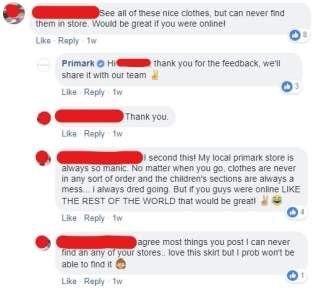 Image 4. Witty comments.
Image 4. Witty comments.
 Image 5. Constructive criticism.
Image 5. Constructive criticism.
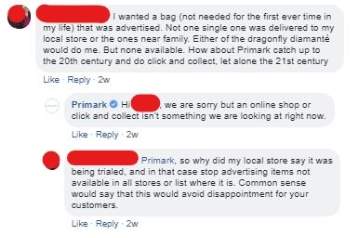 Image 6. Upset and disappointed.
Image 6. Upset and disappointed.
Mintel’s (2017) and McKinsey’s (2017) illustrate the mobility of fashion shopping, as well as the industry’s widescale adoption of technology in terms of point of sale access and ease of sale. Although the lack of this hinders service, none of the examples show evidence of brand avoidance or disruption of loyalty. On the contrary, Primark’s consumers show that they are willing to reach great lengths (literally – through travelling from store to store) to find their products, prior to purchasing elsewhere. Conclusively, this apparent consumer loyalty contributes to the overall brand equity (Aaker, 1992).
As evident, some comments also hint to greater managerial problems of poor retail environment management. This was another common criticism for the company; what is advertised is often not found in-store, leaving a lot of consumers unhappy (see Appendix 5). This is a common issue in the fast fashion industry, as Barnes and Lea-Greenwood’s (2010) study concludes that the operational strategy of retail environments is not progressing at a sufficient rate to meet the requirements of flexibility set by the supply chain and logistical parts of the fast fashion model, leading to missed opportunities for profit maximisation due to challenges of managing stock display, staff or service.
As previously stated through, the community is supportive of the brand, and many examples could be found, such as the one illustrated below (Image 4), where the company is praised for their efforts in making the shopping environment better for their consumers.

Image 4. Consumer feedback on store re-modelling.
Some examples from Appendix 5 further illustrate the division amongst the community in terms of experience levels, discussed in section 4.2., where some attempt to educate others, specifically illustrating patience towards the brand or acting as advocates. This naturally generates a higher engagement rate on all social media, which aids the reach on company posts and counters the effect of the lower corporate engagement on the pages and lack of personalisation in responses (Arriaga et al., 2017; Jonest et al., 2009).
4.6. Summary: Addressing the Research Question.
To summarise, the analysis and subsequent discussions brought to light some crucial aspects of Primark’s marketing strategy, which assist its brand equity boost, such as use of colours or utilisation of user-generated media as unpaid promotion. Although sustainability concerns appear to be spreading by whistle-blowers in the community, the low prices are a deciding factor for Primark’s returning customers. Brand advocacy and brand loyalty are high and assist in terms of stress level management amongst community members, specifically in the context of retail environment appraisal or lack of online store. A strong sense of belonging is felt within the community, which is argued to further motivate consumers to contribute with media, aiming to educate others and purchase, and subsequently remain part of a social group.
If you need assistance with writing your dissertation, our professional Dissertation Writing Service is here to help!
Find out moreChapter V. Conclusion
5.1. Structure.
The aim of this dissertation has been to provide a structured and methodological perspective on the evolution of marketing strategies, which the fast fashion retailer Primark has used throughout its historical development. In chapter I an overall view of the area of research was provided, as well as a rationale for the undertaken research. Chapter II introduced an analysis of literature, specific to the case study organisation Primark and synthesised it, based on the historical development of the organisation, allowing an evolutionary perspective of their marketing approach to form. Further, in chapter III the methodological approach was presented, illustrating various characteristics of the research project, including ethical considerations and limitations. Chapter IV presented the data in an analytical format, discussing it in the context of a wider scope of literature, comparing findings of other authors. Finally, in the conclusive chapter a summary of the undertaken research will be provided, followed by recommendations for managing bodies of the organisation in terms of strategic marketing direction and for other researchers, interested in furthering the literature on the topic.
5.2. Findings Overview.
In terms of literature, this research provides a historical perspective of Primark’s market growth, summarising and critically discussing studies in the context of marketing strategy evolution. The company’s marketing agenda has been found to shift in line with its organisational capabilities, utilising naturally-occurring WOM and spreading brand awareness prior to expansion plans or launching new forms of media. Overall, Primark followed throughout with a structured approach in terms of market positioning, operations and international market penetration, progressively gaining the loyalty of its consumers. In terms of marketing, they ensured the Primark brand grew in line with the organisation, undergoing a packaging, sub-brand and store transformation (The One Off, 2018), introducing contemporary marketing techniques to their portfolio, social media (Ratcliff, 2014), influencer marketing (Smith et al., 2018) and user-generated media.
The netnographic research, analysing consumers of three social media communities, illustrated Primark also benefits from a strong community, where members share feelings of belonging and support for one another. Where also high experience levels lead to brand advocacy and embassy, acting to the company’s defence with regards to instances of poor retail environment management or lack of digitalised selling. An unanticipated finding was the role of colour, used in products and content marketing, as a factor for attracting attention with the aim of higher volume of purchases.
Amongst others, arguably the most significant limitation of the presented findings is their interpretative nature, dependant on individual researcher experience in the computer-mediated community of consumers, subjective to bias (Silverman, 2013; Denzin and Lincoln, 1994).
5.3. Recommended marketing direction.
Relative of findings it is recommended that the organisation encourages a synergetic community through the creation of a corporate-owned social environment for its members. A space for their consumers to interact directly with each other and the organisation will enable the brand to better connect with its community, but also provide them with insight and data, which can be used to better target future marketing campaigns.
Considering the growing concern of sustainable disposal of clothing, purchased from fast fashion retailers, it is also argued that it will be beneficial for the organisation to deploy re-purposing and re-cycling initiatives, where consumers can bring unwanted clothing in-store for it to be utilised by the brand in future production cycles. As well as increasing its precepted sustainability profile, this strategy will provide consumers with another reason to visit the stores and replace their unwanted apparel with more fashionable and trending items.
5.4. Future research directions.
This research is argued to provide the foundations in terms of the historical analysis of Primark’s marketing strategy. Progress has been made in terms of synthesising and pin-pointing key techniques, used at times of foundation, international expansion and in present day. Nonetheless, although the actual research carried out in the online community provided some insight into the consumer society of Primark, as well as the effect of their strategy on purchase motivation, further research is needed for the findings to be validated. One such project can undertake an ethnography analysis in-store to test the effect on colour and atmospheric cues on volume of purchase. Additionally, the consumer behaviour in the community can be tested quantitatively, to assess hierarchy, societal roles in the community and the effect of active engagement on repeated purchase.
Bibliography
Aaker, D.A., 1992. The value of brand equity. Journal of business strategy, 13(4), pp.27-32.
ABF, 2012. Our Businesses. [company website] [viewed 28.09.2018] Available from: https://www.abf.co.uk/about_us/our_group/our_businesses
Armitage, J., 2005. H&M sues Primark over 'copied' designs. Evening Standard. 9th March [online] [viewed 28.09.2018] Available from: https://www.standard.co.uk/news/hm-sues-primark-over-copied-designs-7254398.html
Arriaga, J.L.D.O., Andreu Domingo, D. and Berlanga Silvente, V., 2017. Facebook in the low-cost fashion sector: the case of Primark. Journal of Fashion Marketing and Management: An International Journal, 21(4), pp.512-522.
Arrigo, E., 2018. The key role of retail stores in fast fashion companies: The H&M case study. In Contemporary Case Studies on Fashion Production, Marketing and Operations (pp. 121-137). Springer, Singapore.
Babin, B.J., Darden, W.R. and Griffin, M., 1994. Work and/or fun: measuring hedonic and utilitarian shopping value. Journal of consumer research, 20(4), pp.644-656.
Ballantine, P.W., Parsons, A. and Comeskey, K., 2015. A conceptual model of the holistic effects of atmospheric cues in fashion retailing. International Journal of Retail & Distribution Management, 43(6), pp.503-517.
Barnes, L. and Lea-Greenwood, G., 2010. Fast fashion in the retail store environment. International Journal of Retail & Distribution Management, 38(10), pp.760-772.
Baumeister, R.F. and Leary, M.R., 1997. Writing narrative literature reviews. Review of general psychology, 1(3), p.311
Beaulieu, A., 2004. Mediating ethnography: objectivity and the making of ethnographies of the internet. Social epistemology, 18(2-3), pp.139-163.
Belk, R.W., 1988. Possessions and the extended self. Journal of consumer research, 15(2), pp.139-168.
Belk, R.W., 2013. Extended self in a digital world. Journal of Consumer Research, 40(3), pp.477-500.
Bhardwaj, V. and Fairhurst, A., 2010. Fast fashion: response to changes in the fashion industry. The International Review of Retail, Distribution and Consumer Research, 20(1), pp.165-173.
Binotto, C. and Payne, A., 2017. The poetics of waste: Contemporary fashion practice in the context of wastefulness. Fashion Practice, 9(1), pp.5-29.
Birtwistle, G. and Moore, C.M., 2007. Fashion clothing–where does it all end up?. International Journal of Retail & Distribution Management, 35(3), pp.210-216.
Bloomberg, L.D. and Volpe, M., 2012. Completing your qualitative dissertation: a road map from beginning to end: a road map from beginning to end. Sage.
Bowler Jr, G.M., 2010. Netnography: A method specifically designed to study cultures and communities online. The Qualitative Report, 15(5), pp.1270-1275.
Bruce, M., Daly, L. and Towers, N., 2004. Lean or agile: a solution for supply chain management in the textiles and clothing industry?. International journal of operations & production management, 24(2), pp.151-170.
Butler, S., 2018. Primark primed to overtake Next as UK's No 2 clothing retailer. The Guardian. 18. Janurary. [online] [viewed 28.09.2018] Available from: https://www.theguardian.com/business/2018/jan/18/primark-primed-overtake-next-uk-no-2-clothing-retailer
Christopher, M., Lowson, R. and Peck, H., 2004. Creating agile supply chains in the fashion industry. International Journal of Retail & Distribution Management, 32(8), pp.367-376.
Costello, L., McDermott, M.L. and Wallace, R., 2017. Netnography: range of practices, misperceptions, and missed opportunities. International Journal of Qualitative Methods, 16(1), p.1609406917700647.
Cuc, S. and Tripa, S., 2007. Strategy and Sustainable Competitive Advantage: The Case of Zara Fashion Chain. Fascicle of Management and Technological Engineering, 6, pp.2521-2524.
Dach, L. and Allmendinger, K., 2014. Sustainability in Corporate Communications and its Influence on Consumer Awareness and Perceptions: A study of H&M and Primark. Procedia-Social and Behavioral Sciences, 130, pp.409-418.
Davis, F., 1994. Fashion, culture, and identity. University of Chicago Press.
Denzin, N.K. and Lincoln, Y.S., 1994. Handbook of qualitative research. Sage publications, inc.
Diep, V.C.S. and Sweeney, J.C., 2008. Shopping trip value: do stores and products matter?. Journal of retailing and consumer services, 15(5), pp.399-409.
Doherty, N.F. and Ellis-Chadwick, F., 2010. Internet retailing: the past, the present and the future. International Journal of Retail & Distribution Management, 38(11/12), pp.943-965.
Doran, G.T., 1981. There’sa SMART way to write management’s goals and objectives. Management review, 70(11), pp.35-36.
Dunford, M., 2006. Industrial districts, magic circles, and the restructuring of the Italian textiles and clothing chain. Economic Geography, 82(1), pp.27-59
Easey, M. ed., 2009. Fashion marketing. John Wiley & Sons.
Fan, Y.W. and Miao, Y.F., 2012. Effect of electronic word-of-mouth on consumer purchase intention: The perspective of gender differences. International Journal of Electronic Business Management, 10(3), p.175.
Ferdows, K., Lewis, M. A., Machuca, J. A. D., 2004. Rapid-fire fulfillment. Harvard Business Review, 82(11): 104–110.
Ferdows, K., Lewis, M.A. and Machuca, J.A., 2005. Zara’s secret for fast fashion. Harvard Business Review, 82(11), pp.98-111.
Filieri, R., 2015. From market-driving to market-driven: an analysis of Benetton’s strategy change and its implications for long-term performance. Marketing Intelligence & Planning, 33(3), pp.238-257.
Frings. G.S., 2009. Fashion: from concept to consumer. Prentice Hall: Englewood Cliffs, NJ.
Frith, M., 2005. Monsoon sues Primark for 'copying designs' as cut-price war intensifies. Independent. 19th April [online] [viewed 28.09.2018] Available from: https://www.independent.co.uk/news/uk/crime/monsoon-sues-primark-for-copying-designs-as-cut-price-war-intensifies-495386.html
Ghemawat, P., Nueno, J.L. and Dailey, M., 2003. ZARA: Fast fashion (Vol. 1). Boston, MA: Harvard Business School.
Grant, K., 2018. Primark repositions itself as an ethical retailer – but will shoppers buy it? iNews. 9th February [online] [viewed 28.09.2018]
Available from: https://inews.co.uk/news/primark-releases-details-1071-factories-effort-reposition-ethical-retailer/
Gu, B., Park, J. and Konana, P., 2012. Research note—the impact of external word-of-mouth sources on retailer sales of high-involvement products. Information Systems Research, 23(1), pp.182-196.
Guba, E.G. and Lincoln, Y.S., 1981. Effective evaluation: Improving the usefulness of evaluation results through responsive and naturalistic approaches. Jossey-Bass.
Hansen, S., 2012. How Zara grew into the world’s largest fashion retailer. The New York Times, 9.
Harris, L. and Rae, A., 2009. Social networks: the future of marketing for small business. Journal of business strategy, 30(5), pp.24-31.
Hart, C., 2018. Doing a Literature Review: Releasing the Research Imagination. Sage.
Hirschman, E.C. and Holbrook, M.B., 1982. Hedonic consumption: emerging concepts, methods and propositions. The Journal of Marketing, pp.92-101.
Hung, K.H. and Li, S.Y., 2007. The influence of eWOM on virtual consumer communities: Social capital, consumer learning, and behavioral outcomes. Journal of advertising research, 47(4), pp.485-495.
Instant Live Stats, 2018. Twitter Usage Statistics. Instantlivestats.com [online] [viewed 29.09.2018] Available from: http://www.internetlivestats.com/twitter-statistics/
Jones, B., Temperley, J. and Lima, A., 2009. Corporate reputation in the era of Web 2.0: the case of Primark. Journal of marketing management, 25(9-10), pp.927-939.
Jones, R.M., 2006. The apparel industry. Blackwell: Oxford.
Joy, A., Sherry Jr, J.F., Venkatesh, A., Wang, J. and Chan, R., 2012. Fast fashion, sustainability, and the ethical appeal of luxury brands. Fashion theory, 16(3), pp.273-295.
Keats, E.S., 2012. Exploring haul videos on YouTube: A collective case study approach. Colorado State University.
Ko, E. and Megehee, C.M., 2012. Fashion marketing of luxury brands: Recent research issues and contributions. Journal of Business Research, 65(10), pp.1395-1398.
Kolo, C. and Vogt, P., 2004. Traditional media and their internet spin-offs: An explorative study on key levers for online success and the impact of offline reach. International Journal on Media Management, 6(1-2), pp.23-35.
Kozinets, R. V., 2010. Netnography. Thousand Oaks, CA: Sage.
Kozinets, R.V., 2002. The field behind the screen: Using netnography for marketing research in online communities. Journal of marketing research, 39(1), pp.61-72.
Kozinets, R.V., Dolbec, P.Y. and Earley, A., 2014. Netnographic analysis: Understanding culture through social media data. The SAGE handbook of qualitative data analysis, pp.262-276.
Kozinets, R.V., Sherry, J.F., DeBerry-Spence, B., Duhachek, A., Nuttavuthisit, K. and Storm, D., 2002. Themed flagship brand stores in the new millennium: theory, practice, prospects☆. Journal of retailing, 78(1), pp.17-29.
Leary, M.R., 1995. Self-presentation: Impression management and interpersonal behavior. Brown & Benchmark Publishers.
Lin, Y.T. and Parlaktürk, A., 2012. Quick response under competition. Production and Operations Management, 21(3), pp.518-533.
Lloyd, A.E. and Luk, S.T., 2010. The devil wears Prada or Zara: A revelation into customer perceived value of luxury and mass fashion brands. Journal of Global Fashion Marketing, 1(3), pp.129-141.
Lopez, C. and Fan, Y., 2009. Internationalisation of the Spanish fashion brand Zara. Journal of Fashion Marketing and Management: An International Journal, 13(2), pp.279-296.
MacCarthy, B.L. and Jayarathne, P.G.S.A., 2010. Fast fashion: achieving global quick response (GQR) in the internationally dispersed clothing industry. In Innovative Quick Response Programs in Logistics and Supply Chain Management (pp. 37-60). Springer, Berlin, Heidelberg.
McAfee, A., Dessain, V. and Sjöman, A., 2007. Zara: IT for fast fashion. Cambridge: Harvard Business School.
McAteer, O., 2014. ‘The food we eat wouldn’t even be given to dogs or pigs’: Third Primark SOS note found. The Metro [online article] [viewed on 28.09.2018] Available from: https://metro.co.uk/2014/06/26/the-food-we-eat-wouldnt-even-be-given-to-dogs-or-pigs-third-primark-sos-note-found-4776176/?ito=cbshare
McColl, J. and Moore, C., 2011. An exploration of fashion retailer own brand strategies. Journal of Fashion Marketing and Management: An International Journal, 15(1), pp.91-107.
McCormick, H., Cartwright, J., Perry, P., Barnes, L., Lynch, S. and Ball, G., 2014. Fashion retailing–past, present and future. Textile Progress, 46(3), pp.227-321.
McKinsey, 2017. The State of Fashion 2018. The Business of Fashion and McKinsey & Company. [viewed 27.09.2018] Available from: https://cdn.businessoffashion.com/reports/The_State_of_Fashion_2018_v2.pdf
Mellahi, K., Jackson, P. and Sparks, L., 2002. An exploratory study into failure in successful organisations: The case of Marks & Spencer. British Journal of Management, 13(1), pp.15-29.
Meyer, P.J., 2003. Attitude is Everything!: If You Want to Succeed Above and Beyond. Paul J. Meyer Resources.
Mintel, 2017. Brits Hung Up On Online Fashion: Online Sales Of Clothing, Fashion Accessories And Footwear Grow By 17% In 2017. Mintel Press Office. September [viewed 27.09.2018] Available from: http://www.mintel.com/press-centre/fashion/uk-online-sales-of-clothing-fashion-accessories-and-footwear-grow-by-17-in-2017
Mohr, I., 2013. The impact of social media on the fashion industry. Journal of Applied Business and Economics, 15(2), pp.17-22.
Moore, C.M. and Doherty, A.M., 2007. The international flagship stores of luxury fashion retailers. Fashion Marketing, 277.
O'Connor, Z., 2015. Colour, contrast and gestalt theories of perception: The impact in contemporary visual communications design. Colour Research & Application, 40(1), pp.85-92.
Primark, 2018. About us. [company website][viewed 28.09.2018] Available from: https://m.primark.com/en/about-us/about-primark
Ratcliff, Ch., 2014. How Primark achieved 1.7m Facebook Likes in just six months. Econsultancy. 26th February. [viewed 22.09.2018] Available from: https://econsultancy.com/how-primark-achieved-1-7m-facebook-likes-in-just-six-months/
Rear, J., 2017. A Designer Has Accused Primark Of Stealing Her Blouse Design. Pretty 52. 28th March. [online] [viewed 28.09.2018] Available from: http://www.pretty52.com/stylish/fashion-a-designer-has-accused-primark-of-stealing-her-blouse-design-20170328
Research and Markets, 2017. The UK Clothing Market 2017-2022 June 2017. Research and Markets. [viewed 27.09.2018] Available from: https://learn.solent.ac.uk/mod/book/view.php?id=3381&chapterid=3471
Richardson, N. and Gosnay, R.M., 2010. A quick start guide to social media marketing: High impact low-cost marketing that works. Kogan Page Publishers.
Ritch, E.L. and Schröder, M.J., 2012. Accessing and affording sustainability: The experience of fashion consumption within young families. International journal of consumer studies, 36(2), pp.203-210.
Robertson, R., 1994. Globalisation or glocalisation?. Journal of International Communication, 1(1), pp.33-52.
Rowley, J., 2009. Online branding strategies of UK fashion retailers. Internet Research, 19(3), pp.348-369.
Runfola, A. and Guercini, S., 2013. Fast fashion companies coping with internationalization: driving the change or changing the model?. Journal of Fashion Marketing and Management: An International Journal, 17(2), pp.190-205.
Sharma, B., 2016. Chapter 11: Globalisation and localisation. In. Petermans, A. and Kent, A. (Eds.) Retail Design: Theoretical Perspectives, Routledge: New York, p.197.
Silverman, D., 2013. Doing qualitative research: A practical handbook. SAGE Publications Limited.
Smith, B.G., Kendall, M.C. and Knighton, D., 2018. Rise of the Brand Ambassador: Social Stake, Corporate Social Responsibility and Influence among the Social Media Influencers. Communication Management Review, 3(01), pp.6-29.
Statista, 2018a. Share of clothing market held by Primark in the United Kingdom (UK) from 2007 to 2018. Statista.com [viewed 28.09.2018] Available from: https://www.statista.com/statistics/787728/primark-clothing-market-share-united-kingdom-uk/
Statista, 2018b. Number of stores of Associated British Foods' retail division worldwide from 2014 and 2017, by country. Statista.com [viewed 28.09.2018] Available from: https://www.statista.com/statistics/486148/primark-store-numbers-by-country/
Sudbury, L. and Böltner, S., 2011. Fashion marketing and the ethical movement versus individualist consumption: Analysing the attitude behaviour gap. ACR European Advances.
The One Off, 2018. Primark. [online] [viewed 28.09.2018] Available from: https://www.theoneoff.com/project/primark/
Tokatli, N., 2008. Global sourcing: insights from the global clothing industry—the case of Zara, a fast fashion retailer. Journal of Economic Geography, 8(1), pp.21-38.
Twitter, 2014. Primark [corporate media] [viewed 28.09.2018] Available from: https://twitter.com/primark/status/428810002544226304
Willems, K., Janssens, W., Swinnen, G., Brengman, M., Streukens, S. and Vancauteren, M., 2012. From Armani to Zara: Impression formation based on fashion store patronage. Journal of Business Research, 65(10), pp.1487-1494.
Willis, P. and Trondman, M., 2000. Manifesto for ethnography. Ethnography, 1(1), pp.5-16.
Wolny, J. and Mueller, C., 2013. Analysis of fashion consumers’ motives to engage in electronic word-of-mouth communication through social media platforms. Journal of marketing management, 29(5-6), pp.562-583.
Yu, M., Cao, D. and Tan, J.Y., 2018. CSR-consumption paradox: examination of UK apparel companies. Journal of Fashion Marketing and Management: An International Journal.
Zhou, E., Zhang, J., Gou, Q. and Liang, L., 2015. A two period pricing model for new fashion style launching strategy. International Journal of Production Economics, 160, pp.144-156.
Ziskind, J., Nueno, J.L. and Villanueva, J., 2011. Primark: The power of bargains. IESE Insight, [viewed 27.09.2018] Available from: www.ieseinsight.com/doc.aspx?id=1274&ar=12&idioma=1
Appendices.
Appendix 1. Traditional Offline Advertising Example – Ad on a bus from ci. 1980s (Source: Twitter, 2014).

Appendix 2. Examples of packaging and store layout, following Introduction of 12 new sub-brands (Source: The One Off, 2018).




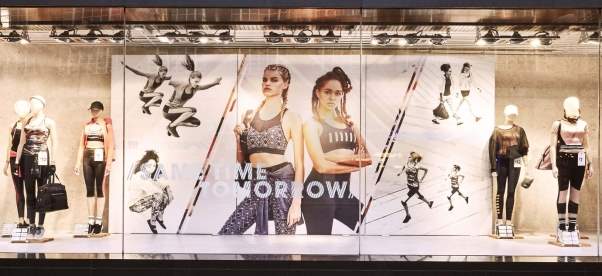
Appendix 3. Influencer Zoella (Source: Youtube, n.d.)



Appendix 4. Facebook Search for Fan-Based communities and Lack of Data validity (Source: Facebook)
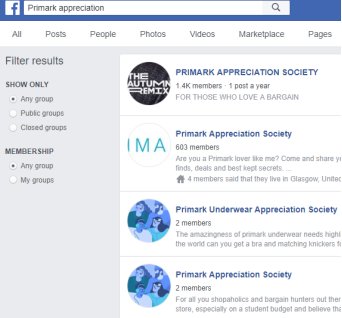


Appendix 5. Consumer Appeal for better Retail Management.




Cite This Work
To export a reference to this article please select a referencing style below:




